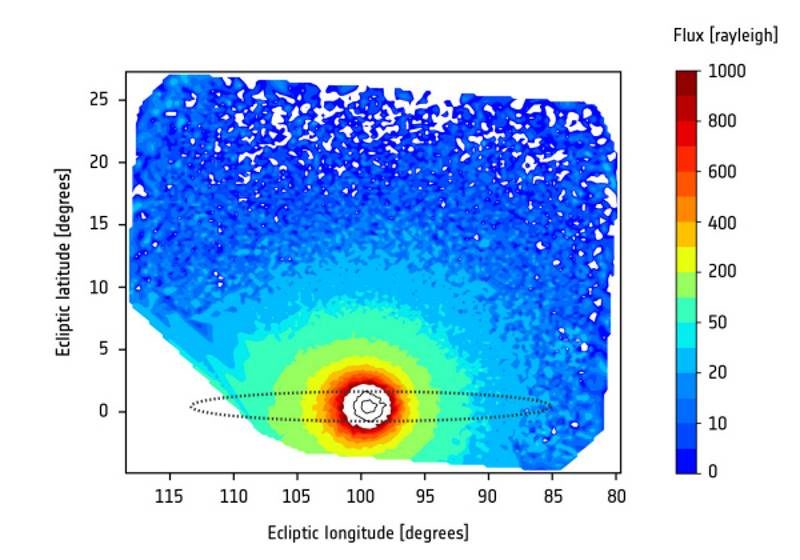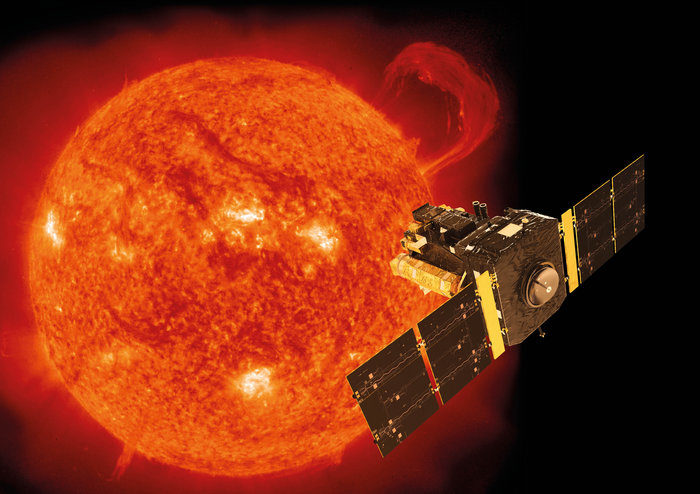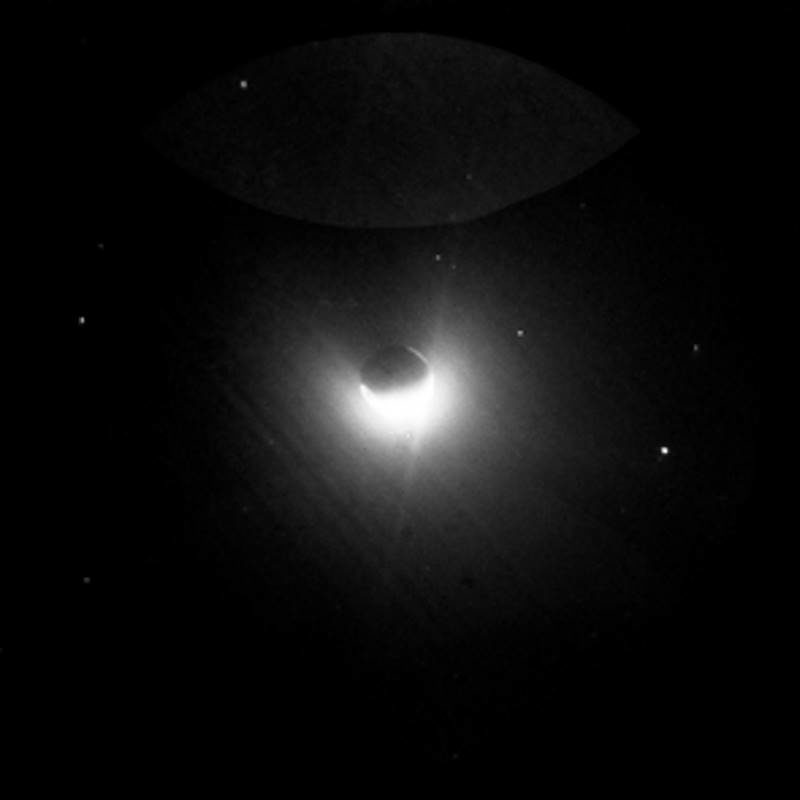A recent discovery based on observations by the ESA/NASA Solar and Heliospheric Observatory, SOHO, shows that the gaseous layer that wraps around Earth reaches up to 630,000 km away, or 50 times the diameter of our planet.
"The Moon flies through Earth's atmosphere," says Igor Baliukin of Russia's Space Research Institute, lead author of the paper presenting the results.
"We were not aware of it until we dusted off observations made over two decades ago by the SOHO spacecraft."
Where our atmosphere merges into outer space, there is a cloud of hydrogen atoms called the geocorona. One of the spacecraft instruments, SWAN, used its sensitive sensors to trace the hydrogen signature and precisely detect how far the very outskirts of the geocorona are.
These observations could be done only at certain times of the year, when the Earth and its geocorona came into view for SWAN.
For planets with hydrogen in their exospheres, water vapour is often seen closer to their surface. That is the case for Earth, Mars and Venus.
"This is especially interesting when looking for planets with potential reservoirs of water beyond our Solar System," explains Jean-Loup Bertaux, co-author and former principal investigator of SWAN.
The first telescope on the Moon, placed by Apollo 16 astronauts in 1972, captured an evocative image of the geocorona surrounding Earth and glowing brightly in ultraviolet light.
"At that time, the astronauts on the lunar surface did not know that they were actually embedded in the outskirts of the geocorona," says Jean-Loup.
Cloud of hydrogen
The Sun interacts with hydrogen atoms through a particular wavelength of ultraviolet light called Lyman-alpha, which the atoms can both absorb and emit. Since this type of light is absorbed by Earth's atmosphere, it can only be observed from space.
Thanks to its hydrogen absorption cell, the SWAN instrument could selectively measure the Lyman-alpha light from the geocorona and discard hydrogen atoms further out in interplanetary space.
The new study revealed that sunlight compresses hydrogen atoms in the geocorona on Earth's dayside, and also produces a region of enhanced density on the night side. The denser dayside region of hydrogen is still rather sparse, with just 70 atoms per cubic centimeter at 60,000 kilometers above Earth's surface, and about 0.2 atoms at the Moon's distance.

The good news is that these particles do not pose any threat for space travelers on future crewed missions orbiting the Moon.
"There is also ultraviolet radiation associated to the geocorona, as the hydrogen atoms scatter sunlight in all directions, but the impact on astronauts in lunar orbit would be negligible compared to the main source of radiation - the Sun," says Jean-Loup Bertaux.
On the down side, the Earth's geocorona could interfere with future astronomical observations performed in the vicinity of the Moon.
"Space telescopes observing the sky in ultraviolet wavelengths to study the chemical composition of stars and galaxies would need to take this into account," adds Jean-Loup.
The power of archives
Launched in December 1995, the SOHO space observatory has been studying the Sun, from its deep core to the outer corona and the solar wind, for over two decades. The satellite orbits around the first Lagrange point (L1), some 1.5 million kilometres from Earth towards the Sun.

Jean-Loup and Igor's research team in Russia decided to retrieve this data set from the archives for further analysis. These unique views of the whole geocorona as seen from SOHO are now shedding new light on Earth's atmosphere.
"Data archived many years ago can often be exploited for new science," says Bernhard Fleck, ESA SOHO project scientist. "This discovery highlights the value of data collected over 20 years ago and the exceptional performance of SOHO."
More information
"SWAN/SOHO Lyman-α mapping: the Hydrogen Geocorona extends well beyond the Moon" by I. Baliukin et al. is accepted in Journal of Geophysical Research: Space Physics.
For further information, please contact:
Igor Baliukin
Space Research Institute
Russian Academy of Science
Moscow, Russia
Email: igor.baliukingmail.com
Jean-Loup Bertaux
Former principal investigator of SWAN
Laboratoire Atmosphères, Milieux, Observations Spatiales (LATMOS)
Université de Versailles-Saint-Quentin-en-Yvelines, France
Email: jean-loup.bertauxlatmos.ipsl.fr
Bernhard Fleck
SOHO project scientist
European Space Agency
Email: bfleckesa.nascom.nasa.gov
Markus Bauer
ESA Science Programme Communication Officer
Tel: +31 71 565 6799
Mob: +31 61 594 3 954
Email: markus.baueresa.int





Flat Earthers (or Flerfers) are not about popular physics or even the shape of the planet, they are a protest movement (created by the government) against NASA's obviously flawed (and hopelessly corrupt) universe modal. Govt does this all the time. It's called Controlled Opposition. So what is NASA hiding with it's fake Flat Earth Movement which enjoys endless media coverage? NASA is a #sciencefiction created after WW2 to hide the secrets of the world: The earth is a hollow #dysonsphere with EM-opposed concentric shells making up the body. The moon is small, hollow, self-lit & close (within the Van Allen Belts & within the earth's outer atmosphere). Gravity is really Electromagnetism (Electric Universe), unrelated to Mass. Space-time does not exist. Dark matter does not exist. Global warming (ozone layer) was caused by Aerosol #geoengineering (Chemtrails), not carbon. All Jumbo/Cargo Jets hide secret Anti-gravity technology since the B19 bombers of WW2 won the war. The British World Atlas is a lie; NO HUGE OCEANS. We're much closer together than that! Pirates were known for navigating the secret shortcuts between continents and planes. We have never seen a real 100% image of Earth, Mars, Saturn, Jupiter, Pluto etc. NASA tells us Mars has icecaps when instead it has #HolesAtThePoles with circular cloud cover. So does Earth. Earth used to be a (polar-oriented) Moon of the planet Saturn. Saturn (EL) is the God of Abraham and the mother planet that created Earth. Every human civilization watched Saturn, Venus, and Mars dance in the sky in very close proximity to Earth (often causing cataclysm), and they drew what they witnessed from a giant cross / morning star (Christ is the Sun), to a Sun + Saturn Crescent (Islam) to the black cube of Saturn (Judaism kabbalah => cube allah => cube god). Gotta use your own brain and do original research, otherwise NASA just another blind faith religion. Citation: Velikovsky Worlds in Collision
[Link] [Link]